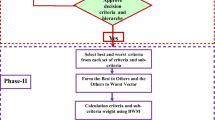Abstract
The technique for order preference by similarity to ideal solution (TOPSIS) is a classical method first developed by Hwang and Yoon,1 subsequently discussed by many.2 TOPSIS is based on the concept that alternatives should be selected that have the shortest distance from the positive ideal solution (PIS) and the longest distance from the negative ideal solution (NIS), or nadir. The PIS has the best measures over all attributes, while the NIS has the worst measures over all attributes.
Access this chapter
Tax calculation will be finalised at checkout
Purchases are for personal use only
Preview
Unable to display preview. Download preview PDF.
Similar content being viewed by others
Notes
C.L. Hwang, K. Yoon (1981) Multiple Attribute Decision Making: Methods and Applications. Springer-Verlag.
Y. Peng (2000) Management Decision Analysis. Science Publication;
T.-C. Chu (2002) ‘Facility location selection using fuzzy TOPSIS under group decisions,’ International Journal of Uncertainty, Fuzziness & Knowledge-Based Systems, 10 (6): 687–701.
D.L. Olson (2005) ‘Comparison of weights in TOPSIS models,’ Mathematical and Computer Modelling, 40: 721–727.
M. Freimer, P.L. Yu (1976) ‘Some new results on compromise solutions for group decision problems,’ Management Science, 22 (6): 688–693;
T.E. Dielman (2005) ‘Least absolute value regression: recent contributions,’ Journal of Statistical Computation & Simulation, 75 (4): 263–286.
S.C. Caples, M.E. Hanna (1997) ‘Least squares versus least absolute value in real estate appraisals,’ Appraisal Journal, 65 (1): 18–24.
G.W. Bassett, Jr. (1997) ‘Robust sports rating based on least absolute errors,’ American Statistician, 51 (2): 99–105.
S.M. Lee, D.L. Olson (2004) ‘Goal programming formulations for a comparative analysis of scalar norms and ordinal vs. ratio data,’ Information Systems and Operational Research, 42 (3): 163–174.
A. Barnes (1987) ‘The analysis and use of financial ratios: a review article’, Journal of Business and Finance Accounting, 14: 449–461;
H. Deng, C.-H. Yeh, R.J. Willis (2000) ‘Inter-company comparison using modified TOPSIS with objective weight’, Computers & Operations Research, 27: 963–973.
D.L. Olson (2004) ‘Data set balancing’, Lecture Notes in Computer Science: Data Mining and Knowledge Management, Y. Shi, W. Xu, Z. Chen, eds. Springer, 71–80.
J. Laurikkala (2002) ‘Instance-based data reduction for improved identification of difficult small classes’, Intelligent Data Analysis, 6 (4): 311–322.
B. Bull (2005) ‘Exemplar sampling: Nonrandom methods of selecting a sample which characterizes a finite multivariate population,’ American Statistician, 59 (2): 166–172.
D.L. Olson, D. Wu (2006) ‘Simulation of fuzzy multiattribute models for grey relationships,’ European Journal of Operational Research, 175 (1): 111–120.
Author information
Authors and Affiliations
Copyright information
© 2015 Desheng Dash Wu and David L. Olson
About this chapter
Cite this chapter
Wu, D.D., Olson, D.L. (2015). Credit Scoring using Multiobjective Data Mining. In: Enterprise Risk Management in Finance. Palgrave Macmillan, London. https://doi.org/10.1057/9781137466297_9
Download citation
DOI: https://doi.org/10.1057/9781137466297_9
Publisher Name: Palgrave Macmillan, London
Print ISBN: 978-1-349-69103-6
Online ISBN: 978-1-137-46629-7
eBook Packages: Palgrave Economics & Finance CollectionEconomics and Finance (R0)




